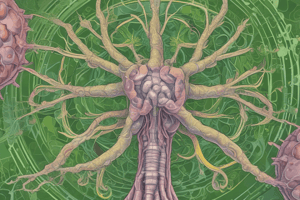Podcast
Questions and Answers
Which of the following receptors is primarily located in the central nervous system?
Which of the following receptors is primarily located in the central nervous system?
- FAAH
- CB1 (correct)
- MGL
- CB2
Endocannabinoids are synthesized and stored in vesicles until needed.
Endocannabinoids are synthesized and stored in vesicles until needed.
False (B)
What is the primary psychoactive compound found in cannabis?
What is the primary psychoactive compound found in cannabis?
Delta-9-tetrahydrocannabinol (THC)
Cannabis sativa is known for having approximately _____ active compounds.
Cannabis sativa is known for having approximately _____ active compounds.
Match the following endocannabinoid compounds with their functions:
Match the following endocannabinoid compounds with their functions:
What year was the first receptor for THC (CB1) identified?
What year was the first receptor for THC (CB1) identified?
Cannabinoid antagonists can be used to suppress appetite.
Cannabinoid antagonists can be used to suppress appetite.
Which compound was identified as inactive in urine tests for THC?
Which compound was identified as inactive in urine tests for THC?
The primary role of endocannabinoids in synaptic transmission is to inhibit the release of __________ from the presynaptic neuron.
The primary role of endocannabinoids in synaptic transmission is to inhibit the release of __________ from the presynaptic neuron.
Which of the following conditions is THC particularly effective for pain relief?
Which of the following conditions is THC particularly effective for pain relief?
Flashcards
Endocannabinoids
Endocannabinoids
Lipid molecules produced by the body that bind to cannabinoid receptors.
CB1 receptor
CB1 receptor
Cannabinoid receptor primarily located in the central nervous system (brain and spinal cord).
CB2 receptor
CB2 receptor
Cannabinoid receptor primarily located in the periphery, including the immune system.
Anandamide
Anandamide
Signup and view all the flashcards
2-AG
2-AG
Signup and view all the flashcards
THC
THC
Signup and view all the flashcards
CBD
CBD
Signup and view all the flashcards
Analgesia
Analgesia
Signup and view all the flashcards
Synaptic Transmission
Synaptic Transmission
Signup and view all the flashcards
Retrograde signaling
Retrograde signaling
Signup and view all the flashcards
Study Notes
Endocannabinoid System
-
Endocannabinoids: Lipid-soluble signaling molecules, not stored in vesicles, synthesized on demand.
-
Functions:
- Analgesia
- Sensory processing
- Motor coordination
- Memory and cognition
- Appetite regulation
- Immune system modulation
-
Synthesis: Derived from arachidonic acid.
-
Receptors:
- CB1: Primarily in the central nervous system (CNS), involved in motor coordination, memory, and sensory processing. Located in basal ganglia, cerebellum, hippocampus, and cortex. Few in brainstem.
- CB2: Primarily in the periphery, including the immune system.
-
Inactivation:
- Anandamide: Broken down by fatty acid amide hydrolase (FAAH) in postsynaptic neurons.
- 2-AG: Broken down by monoacylglycerol lipase (MGL) in presynaptic neurons.
-
Synaptic Transmission:
- Postsynaptic neuron depolarization triggers endocannabinoid release.
- Endocannabinoids diffuse to presynaptic neurons, binding receptors and inhibiting neurotransmitter release (retrograde signaling).
Cannabis
-
Plant: Cannabis sativa and Cannabis indica, cultivated for ~6000 years, originally from Asia, now worldwide.
-
Compounds:
- Varying compounds; ~400 active compounds,
- Psychoactive: Delta-9-tetrahydrocannabinol (THC). Identifed in 1964.
- Non-psychoactive: Cannabidiol (CBD), Cannabinol (CBN).
-
Timeline:
- 1964: THC identified as active component of marijuana.
- 1988: First THC receptor (CB1) identified.
- 1991: Second THC receptor (CB2) identified,
- 1992: Endogenous THC (anandamide & 2-AG) identified.
-
Pharmacokinetics of THC:
- Half-life: ~30 hours.
- Depot binding: "reverse tolerance".
- Metablism: Metabolized in liver to active metabolite (11-hydroxy-delta-9 THC); then into inactive metabolite (carboxy-THC; detectable in urine).
-
Medical Uses of THC:
- Analgesia: Sativex (THC + CBD); effective for inflammatory pain (CB2 action).
- Appetite stimulation: Marinol. Useful in cancer/AIDS.
- Cannabinoid antagonists can suppress appetite. One example is Rimonabant (2006).
Studying That Suits You
Use AI to generate personalized quizzes and flashcards to suit your learning preferences.



